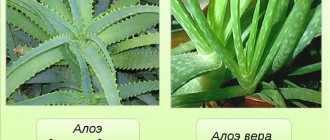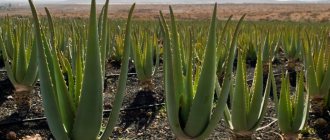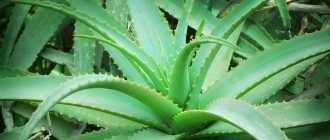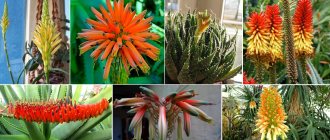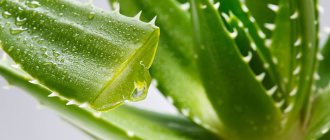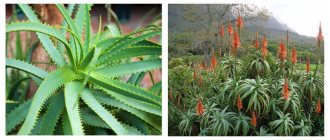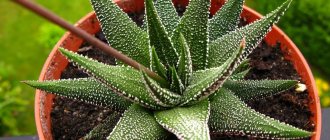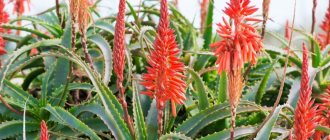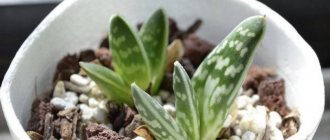For its healing properties and ease of care at home, tree aloe is one of the most popular indoor plants. The evergreen perennial tree-like aloe has another name among gardeners - agave. Many people mistakenly call all varieties of aloe agave. This is a misconception, since only aloe vera is called agave!
Briefly about care
- Watering. Water the plant sparingly, making sure that the top soil layer is sufficiently dry. In winter, the crop needs to be watered less frequently, about several times every 30 days.
- Illumination. A tropical crop needs a significant amount of sunlight, so the bush should be kept on the south side of the windows.
- Air humidity. The African succulent does not need spraying.
- Temperature conditions. The air temperature should not be higher than 25 °C in summer and lower than 13 °C in winter.
- Bloom. At home, the plant does not bloom.
- Trimming. If necessary, you can prune the perennial.
- Transfer. Young specimens need to be replanted every year.
- Priming. The soil mixture should be loose and consist of coarse sand, turf, leaf soil, and humus.
- Fertilizers. Tropical crops should be fed a couple of times a month from March to November.
- Reproduction. By cuttings and seed method.
- Diseases. Root and dry rot.
- Parasites. Mealybug, spider mite, scale insect.
Reproduction
The indoor propagation procedure is as simple as caring for aloe agave. It can be done in several ways. The most commonly used and simplest is cuttings. However, there are also alternative options.
Some people prefer to propagate succulents by rooting leaves. The essence of the procedure is to separate one leaf, which grows at the very base of the stem. Then it is dried a little. Wet sand is poured into the container. The leaf cut is dipped in crushed coal. After this, it is deepened into the sand, no deeper than 3 centimeters. In order for the root system to begin to grow and develop faster, the container is covered with film or polyethylene. The soil should not be allowed to dry out.
The next method is cuttings. Using this particular technique, you will have a much better chance of your succulent growing successfully. However, young cuttings are always a little weak and not strong enough, and therefore are highly susceptible to various diseases and pests. If you strictly follow the instructions, everything will be successful. So, the preparatory stage:
- First, select a healthy mother aloe.
- Find a razor or knife and sanitize it well.
- Select the side shoots of the aloe that grow along the stem. Only those that grow straight and do not have bends in shape are suitable.
- Carefully cut cuttings 10 centimeters long. Each shoot must have at least 6 leaves.
- After cutting, keep the cuttings in a poorly lit place for at least a week. Select this temporary habitat so that the air humidity there is at least 50%. Let the cut area dry.
Aloe or agave
What is the difference between agave and aloe vera? Both plants are succulents and belong to the Asphodelaceae family. However, agave is a subspecies of aloe and resembles a tree or bush with a distinct stem.
Look at the photo to understand the difference between agave and other types of aloe, as well as how to distinguish them.
The difference between tree aloe
What is the difference between aloe and aloe vera besides external signs?
Both plants contain useful and nutritious components, and therefore are actively used in medicine and cosmetology.
Agave and aloe vera have slightly different compositions and are used for different medicinal purposes. Flower growers still argue whether aloe vera or agave is more beneficial. Biologists and pharmacists are inclined to believe that both plants deserve to be on the list of medicinal herbs, since the juice and pulp of the plant are useful for many diseases.
When classifying a succulent, tree aloe is classified as a medicinal plant, not an ornamental one.
What does aloe vera contain?
First of all, aloe leaves contain a gel that is 96% water. The remaining 4% are substances with proven biological activity, more than 270 of them have been found. Aloe is an exceptionally rich source of proteins in the form of amino acids (that is, in their simplest form, which are easiest to digest).
It contains nine of the ten exogenous amino acids necessary for humans (except tryptophan). These are, first of all: histidine, leucine, lysine, phenylalanine, L-arginine, methionine, threonine, tryptophan, valine. This diversity of nutrients is extremely rare among plants.
Aloe pulp contains a large amount of vitamins: beta-carotene, vitamins C, B1, B2, B3, and in small quantities B12. A number of bioelements are also present: potassium, calcium, magnesium, sodium, phosphorus, zinc, sulfur, iron, as well as small amounts of silicon, cobalt, manganese, copper, nickel, boron, aluminum, lithium, chromium, molybdenum, boron, tin.
An extremely valuable component of aloe are enzymes (for example, bradykinase), mono-, bi- and polysaccharides or their derivatives (for example, glucoprotein), which have the ability to bind to proteins of cell membranes and plasma. The most important components, however, are the long-chain sugar molecules.
This composition of aloe promotes an exceptionally comprehensive effect on the human body, especially since we are dealing with a synergistic effect (the interaction of many components enhances the therapeutic effect).
Pharmacological properties of aloe vera
Aloe preparations have a choleretic, laxative effect, have pronounced anti-burn and anti-inflammatory properties, stimulate the secretion of the digestive glands, improve digestion and appetite.
Aloe juice has a bacteriostatic effect against many groups of microbes: streptococci, staphylococci, diphtheria, dysentery and typhoid bacilli.
Description of the plant
The homeland of aloe vera (agave) is hot Africa. The plant got its name because it looks like a miniature tree.
Some people confuse tree aloe with fern or cactus. These are completely different plants.
Photos of tree aloe clearly prove that the perennial crop is similar to a tree. In nature, the crop can reach a height of several meters. In apartment conditions, the succulent grows up to one meter.
History of discovery and geography of habitat
Both species have been known since time immemorial. Aloe vera has a long and documented history of use.
Already the ancient Sumerians knew about its medicinal properties. This is evidenced by a clay tablet from approximately 2100 BC. It is also mentioned in the Egyptian papyrus of 1550 BC, where 12 methods of its medical use are described.
There is a hypothesis that it is Aloe vera that is depicted on the walls of an ancient Egyptian temple about 6000 years old. It is also known that Arab traders brought expensive powder from the leaves of Aloe vera, the “lily of the desert” as they called it, to India. The famous ancient Greek physician Hippocrates highly valued the plant .
Aloe vera is native to the Arabian Peninsula, but the plant is now found in the wild in all temperate and tropical regions, including Australia, China, Mexico, the southern United States, and even southern Spain.
Aloe arborescens was also known to the ancient Egyptians, and they used its juice to mummify the bodies of the dead. It is native to South Africa and is found naturally in Mozambique, Swaziland, Zimbabwe and Malawi. Like its brother, agave is widely cultivated in many warm countries.
Transfer
A perennial should be replanted in certain cases: after purchasing a flower in a store, if the plant is cramped in an old pot, or if the flower is young, then it also needs to be replanted once a year.
To replant, you will need a new pot and soil suitable for the succulent. It doesn’t matter what material the pot is made of, it is important that it has a larger diameter than the previous one.
Transplanting aloe arborescens
During transplantation, an earthen lump is removed from the old pot along with the perennial, see the photo above. You can shake off excess soil and carefully examine the roots of the flower.
The roots must be healthy. Rotten or diseased roots should be carefully trimmed.
After a visual inspection, you should place the flower in a new pot, after pouring a drainage layer there. After placing the plant in a new pot, sprinkle it with soil, filling empty spaces and uneven areas.
There is no need to water the succulent after transplanting.
Caring for aloe vera at home
In terms of care, the aloe tree is a fairly unpretentious plant. However, there are features that should be taken into account in order for the culture to grow and develop well.
Lighting and temperature conditions
Aloe spinosa or aristata - what kind of flower is it?
Aloe is one of the plants that love light, so it is better to choose the most illuminated place for a flower pot. The culture is not afraid of direct sunlight. If the flower has been in the shade for a long time, then it is gradually accustomed to bright lighting. In winter, bushes sometimes need to be additionally illuminated with special lamps.
Watering rules and humidity
During the growing season, watering is carried out immediately after the soil in the pot dries out. In winter, the amount of irrigation is reduced, but it is not recommended to allow the soil to remain constantly dry.
Attention! Watering is carried out only at the root; water should not get inside the outlet. Otherwise, the plant may rot.
Air humidity is not important for tree aloe; the crop grows well under any conditions.
Aloe has fleshy leaves in which the plant accumulates moisture.
Fertilizing and soil quality
During active growth, fertilizers are applied three times per season - in early March, mid-July and early October. It is better to use mineral fertilizers for feeding. You can buy ready-made products for succulents and dilute them according to the instructions.
Aloe really likes soil with a high nitrogen content. The best soil for the crop is considered to be a mixture of turf and deciduous soil with the addition of sand. For looseness, add a small amount of charcoal and small bricks.
Flower container size
For aloe, the stem of which can be tall, choose a medium-sized container. It is important that there is enough space for the root system.
Pruning and replanting
The culture does not like frequent transplants. The first time this should be done immediately after purchase. If the plant is young and actively growing, then it can be replanted every year. Adult flowers are moved to another pot every 3-4 years.
Pruning is needed in order to form the crown of the plant. For rejuvenation, the top parts and side shoots are trimmed. Cut shoots are well suited for flower propagation.
You need to water the aloe carefully so that water does not get into the outlet.
Diseases
Improper care during cultivation can cause agave disease. One of the common diseases is root rot, which appears as a result of frequent and abundant watering.
Root rot in Aloe vera
At the first signs of disease, you should immediately reduce the amount of watering. It is also necessary to transplant the infected plant into another pot, inspecting and removing diseased roots.
To prevent the occurrence of root rot, use gravel, brick chips or charcoal.
In addition to root rot, the plant can develop dry rot. With this disease there are no external signs, because the flower dries from the inside.
Fungal disease in Aloe arborescens
Dry, yellowed leaves are a sign of “poor health” of the agave. Yellowed leaf blades may indicate a fungal disease. Leaves affected by the fungus should be carefully trimmed.
Use of aloe in traditional and folk medicine (recipes)
In traditional and folk medicine, aloe leaf juice is used internally for chronic and atonic constipation, in small doses as a bitter to improve food digestion. The laxative effect appears 8-10 hours after administration.
For chronic gastritis that accompanies constipation, gastric ulcer, after dysentery and to strengthen the body's resistance to infectious diseases, you should take 5-10 ml of juice from fresh aloe leaves, which should be consumed immediately after extraction, 30 minutes before meals 2-3 once a day.
Juice from fresh aloe leaves is used externally to treat burns, purulent wounds, inflammatory skin diseases, etc. In the form of subcutaneous injections of 1 ml, the extract is used for various eye diseases (iritis, conjunctivitis, vitreous opacities, keratitis), as well as for peptic ulcers stomach and duodenum, bronchial asthma.
An emulsion prepared from the juice of aloe leaves (previously kept in the dark at a temperature of 6-8° for 12 days), eucalyptus and castor oils, is used for the prevention and treatment of skin lesions resulting from radiation sickness.
In Chinese folk medicine, aloe juice is recommended for vascular diseases, pulmonary tuberculosis, during menopause and postmenopause, in childhood for diseases accompanied by convulsions, amenorrhea (contraindicated during pregnancy).
Aloe tincture is prepared as follows: crushed leaves, previously cut for a week and a half and kept in a dark place at a temperature of 4-8°, are poured with 70% alcohol or vodka (1 to 5).
The scope of use of aloe preparations in medicine is very extensive:
- juice (externally) – for burns, purulent wounds, trophic ulcers, osteomyelitis, for rinsing in diseases of the gums and oropharynx;
- fresh juice (orally) – to improve appetite, for chronic gastritis, to increase immunity against infectious diseases;
- aloe syrup with iron - after infectious diseases and other debilitating diseases and intoxications, for chronic and acute diseases of the gastrointestinal tract;
- juice (compresses) – for lupus, skin tuberculosis, eczema, radiation dermatitis of the head;
- liquid aloe extract (from fresh, dried or canned leaves - for injection; from crushed canned leaves - for oral administration) - for conjunctivitis, blepharitis, keratitis, for gastric and duodenal ulcers, for chronic gastritis, bronchial asthma, gynecological diseases;
- film-coated tablets containing crushed canned leaf - as a non-specific remedy for the complex treatment of eye diseases;
- aloe liniment containing juice from leaves biostimulated according to Filatov’s method - externally for burns and for the prevention and treatment of radiation damage to the skin.
Pests
Common pests that are dangerous to agave are spider mites, scale insects and mealybugs.
- When a crop is infected by a mealybug, the leaves become covered with an unpleasant whitish coating.
- Spider mites leave behind a substance similar to a cobweb.
- Leaves affected by scale insects feel sticky to the touch.
Scale insects on aloe vera
Pests suck out the sap of the plant, and if action is not taken in time, the succulent will wither and die.
A soap solution or insecticides will help get rid of parasites.
With proper care, the plant rarely gets sick. Carefully care for your indoor succulent, if you see an illness, immediately react and begin treatment, then the flower will thank you with its beautiful appearance and help in the treatment of many diseases.

